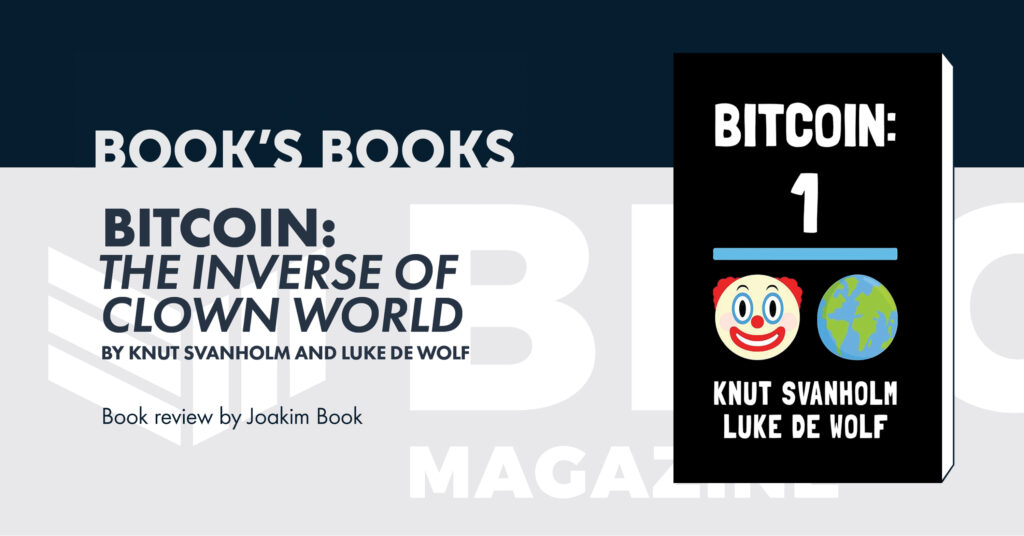Opinion
Wyoming Introduces Bitcoin Strategic Reserve Bill
Published
3 months agoon
By
admin

Looking to cement Wyoming’s position at the forefront of Bitcoin innovation, freshman Representative Jacob Wasserburger (@jacob4wyoming) has introduced the “State Funds-Investment in Bitcoin Act” (HB0201), a bill aimed at creating a Bitcoin Strategic Reserve for the state. Following the footsteps of groundbreaking Bitcoin legislation previously passed in Wyoming, this bill seeks to secure the state’s financial future while paving the way for broader national adoption.
Wyoming: A Tradition of Innovation
“Wyoming has always been a pioneer—from women’s suffrage, to the first national park; from the invention of the LLC, to the frontier of digital assets,” Wasserburger remarked when introducing the bill. “HB0201 ensures that Wyoming remains the leading state for legislative innovation in Bitcoin, while providing our citizens with the long-term benefits of sound money and financial sovereignty.”
HB0201 would allow the allocation of a portion of Wyoming’s state funds into Bitcoin as part of a diversified investment strategy. By doing so, the state aims to capitalize on Bitcoin’s long-term appreciation potential while promoting its principles of decentralization and monetary resilience. The initiative aligns with Wyoming’s established reputation as the most Bitcoin-friendly jurisdiction in the United States, a legacy cultivated by laws such as the Wyoming Special Purpose Depository Institution (SPDI) framework, and includes more than two dozen other laws and regulations passed or promulgated since 2018.
National Collaboration: Supporting Senator Lummis and President-elect Trump
Representative Wasserburger’s ambitions extend beyond Wyoming. The freshman legislator emphasized the importance of supporting efforts by Wyoming Senator Cynthia Lummis and President-elect Donald Trump to establish a United States Strategic Bitcoin Reserve.
“As a proud supporter of Senator Lummis and President-elect Trump’s efforts, I believe Wyoming can play a vital role in this national initiative,” Wasserburger stated. “Building a strategic Bitcoin reserve isn’t just about securing financial strength—it’s about ensuring that both Wyoming and America remain leaders on the global stage.”
This collaboration underscores the growing recognition of Bitcoin as a geopolitical asset. Advocates argue that holding Bitcoin as a reserve asset could hedge against inflation, protect against economic instability, and strengthen the United States’ position in an increasingly digital global economy.
The Economic Case for a Bitcoin Strategic Reserve
At the heart of HB0201 lies an economic argument as compelling as it is revolutionary. Bitcoin, often described as “digital gold,” has demonstrated remarkable resilience and growth over the past decade. For Wyoming, a state that has consistently championed financial independence and innovation, the potential upside of Bitcoin aligns with its long-term vision.
“We can’t afford to sit on the sidelines while other states, like Texas, Pennsylvania, North Dakota, New Hampshire and others move forward with their own Bitcoin reserve bills,” said Wasserburger. “Passing HB0201 quickly ensures that Wyoming remains the leader among the states, setting the standard for financial innovation and sovereignty. With many other states likely to follow suit, now is the time to solidify our position as the trailblazer in the digital economy and ensure Wyoming stays ahead of the pack.”
“Wyoming’s economic future depends on embracing innovation while staying true to our principles of individual liberty and financial independence,” said Wasserburger. “Investing in Bitcoin is not just smart policy—it’s Wyoming’s way of saying we’re ready for the future.”
In a time when states are grappling with economic uncertainty and inflationary pressures, Bitcoin’s fixed supply and decentralized nature offer a stark contrast to traditional financial systems. By adopting HB0201, Wyoming positions itself as a leader not just in Bitcoin regulation, but in integrating Bitcoin into the financial apparatus of state governance.
This is a guest post by Colin Crossman. Opinions expressed are entirely their own and do not necessarily reflect those of BTC Inc or Bitcoin Magazine.
Source link
You may like


Strategy Boosts Bitcoin Holdings Above $47 Billion With Latest Buy


Coinbase CLO Reveals New Details on SEC’s Ethereum 2.0 Investigation Documents


NEAR Gains 11.7%, Leading Index Higher Over Weekend


Bitget’s $12B VOXEL frenzy fizzled fast, but questions remain


BNB Springs Back From $531 With Unshaken Bullish Conviction


This tiny altcoin could see 50x gains before BTC hits 100k
AI
AI flattens creativity. Blockchain is how we save it
Published
2 days agoon
April 19, 2025By
admin
Disclosure: The views and opinions expressed here belong solely to the author and do not represent the views and opinions of crypto.news’ editorial.
Our timelines were just filled with a bunch of pastel Miyazaki’s ghosts. Studio Ghibli-style AI generations have become the internet’s new favorite aesthetic. PFPs and marketing campaigns were reborn overnight in the watercolor warmth of Spirited Away. Selfies rendered as soot sprites.
The results are charming yet deeply unsettling. Why? Because Hayao Miyazaki didn’t draw them––and no one asked permission. This isn’t just a copyright problem. It’s an authenticity problem where there is a growing inability to see, trace, or understand the origins of the content that shapes our culture.
In the chaos of AI-generated images and memecoins, we’re watching creativity get flattened, authorship obscured, and ownership erased. If that feels like a plague, it’s because it is.
The unfettered mess unleashed by generative AI has caused a powerful use case for blockchain to emerge: proof of provenance and onchain verifiability for agentic creation. By anchoring content to public, immutable ledgers, blockchain enables creators to prove authorship, timestamp originality, license works programmatically, and track derivatives across the network—without relying on centralized gatekeepers.
With the tools of blockchain, creators can participate in fairer, more transparent ecosystems that reward origin and empower open-source and composable content systems.
The collapse of creative clarity
Studio Ghibli has not been the only target. In late 2024, Philip Banks created Chill Guy, a laid-back dog meme that exploded into a half-billion-dollar meme token on Solana. But Banks never gave permission. His accounts were hacked. A false licensing deal was forged. When the truth surfaced, the token crashed 45% in 30 minutes.
Now imagine that story playing out across every medium, on a global scale. That’s exactly what’s happening with OpenAI’s recent co-option of Studio Ghibli’s IP. Now, AI’s tools can mimic any voice, style, or aesthetic—trained on unlicensed data scraped from the internet and any medium it can consume.
Amazon is replacing voice actors with AI. Manga localization is being outsourced to machines. Lawsuits from The New York Times, Getty, and independent artists are piling up. A major problem is that enforcement can’t keep pace with reproduction. The systems we rely on to manage content—from cloud drives to social platforms—cannot tell you where something came from.
They fail at proving provenance and, in turn, fail the creators whose livelihoods depend on IP rights. We’re building the next generation of digital culture on a foundation of guesses, not guarantees.
Creative authenticity requires new blockchain infrastructure
We don’t need more IP lawsuits. We need new rails. Authenticity, or even lucidity—the ability to see clearly and act truthfully—is not just a philosophical idea. In a generative world, it’s a technical requirement. If we want to preserve creative integrity in the age of AI, we need infrastructure that makes origin, attribution, and authorship cryptographically native to every digital asset.
Using content-addressable storage and Merkle tree structures, creators can hash their work and register it to a public chain. This hash becomes a permanent fingerprint of the original content. Smart contracts can define licensing conditions, automate royalties, and even govern remix rights.
Each derivative, usage event, or ownership change is logged immutably—creating a verifiable timeline of creation, modification, and transaction. This doesn’t just protect artists. It improves the machines, too. With blockchain, creators can cryptographically register their work at the moment of creation. Every change, license, or remix becomes part of a transparent, tamper-proof timeline. Smart contracts can automate royalties. Attribution becomes verifiable. And usage becomes traceable—whether that’s a social post, a dataset, or an AI-generated derivative.
This isn’t just hype. It’s a structural shift from guesswork to guarantees, from hearsay to hashes.
Without it, artists will keep getting erased. Investors will keep getting rugged. And trust in the creative economy will continue to corrode.
Building a truthful internet
Freedom of communication and property rights are foundational principles in the canon of Western philosophy. We know that open communication channels and the rule of law to protect private property are the frameworks for building a free society.
However, today, our creative systems are plagued with black-box models, closed-source platforms, and training systems on data without audit trails. We have mistaken this flood of content for an abundance of creativity when, in fact, it’s a hollow kind of plenty—one that undermines the creative people it imitates.
If we want a future where new Miyazakis, Picassos, and myriad creators are possible––where artists can take risks without getting scraped into the next proprietary model––we must build systems that protect them by design.
Blockchain is how we embed authorship into content, how we stop laundering aesthetics, and how we let creativity thrive without erasure. This is not just about bad actors. It’s bad architecture. And the cure isn’t outrage—it’s about provenance. Authenticity isn’t a luxury anymore. It’s a blockchain.

Nirav Murthy
Nirav Murthy is a co-founder at Camp Network and has previous experience as an Investment Banking & Growth Equity Associate at The Raine Group. Prior to that, Nirav worked as a Brand Ambassador at CRV. Nirav holds a Bachelor of Science in Business Administration from the University of California, Berkeley, Haas School of Business, and a Bachelor of Arts in Economics from the University of California, Berkeley.
Source link
cross-border payments
Boosting growth in the tokenized credit market
Published
3 days agoon
April 18, 2025By
admin
Disclosure: The views and opinions expressed here belong solely to the author and do not represent the views and opinions of crypto.news’ editorial.
Over the past decade, the tokenized credit market has soared to new heights. The industry, which converts traditional credit products, such as loans, bonds, or other debt instruments, into digital tokens that exist on a blockchain, has helped to democratize the world of investment for more participants, with each token issued representing a fraction of the underlying credit asset. This fractionalisation allows the token to be easily traded, transferred, and managed on decentralised platforms.
To date, $10 billion in tokenized bonds have been issued by leading institutions, including the World Bank and the City of Lugano. The market’s growing popularity stems from the significant benefits it offers—enhanced liquidity, transparency, and accessibility. Investors can now buy and sell portions of loans or bonds, making these traditionally illiquid assets more flexible and tradable. Blockchain’s transparent, immutable ledger ensures that all transactions are secure and verifiable in real time, reducing fraud and increasing trust. Additionally, tokenized credit products open the door to a broader pool of investors by lowering entry barriers, allowing even small-scale participants to invest in assets that were once limited to large institutional players. As more financial institutions and platforms adopt tokenization, this market is expected to expand, transforming how credit products are issued, traded, and managed.
Yet despite this advancement, the growth of the tokenised credit market is still constrained by one critical issue: return on investment. Decentralized finance lending currently offers lower yields when compared to traditional lending markets, especially in the current high-interest rate environment.
This can be solved by providing funding for cross-border payments as it is an ideal use case to expand the tokenized credit market and unlock higher yields, offering consistent cash flows and a natural fit for blockchain’s speed and cost-efficiency.
The core challenges: Low yields and volatility
The total allocation of the tokenized credit market remains relatively small compared to the size of the multi-trillion-dollar global bond market. The limited allocation is largely due to challenges in liquidity, investor hesitancy concerning yields, and regulatory uncertainty.
Concerning returns, the tokenised credit market currently offers an average yield of around 9.65% on $10 billion of tokenised credit assets. While this might seem attractive compared to traditional bond yields, tractional private credit markets saw average yields of 12% from 2018 to 2023, leading many investors to still view DeFi as volatile and uncertain. Therefore, to unlock further growth, it is critical that the industry addresses yield-related issues and enhances investor confidence in the pioneering asset class.
Institutional investors demand not just high yields but also stability and predictability. In traditional credit markets, low volatility and reliable income streams are key drivers of investment flows, whereas the DeFi sector is still seen as nascent and volatile. The ecosystem needs to prove that it can generate attractive, risk-adjusted returns for both institutional and retail investors. This means improving the robustness of the platforms and expanding the range of available asset classes, such as into payments.
Increasing yields to boost growth
To drive greater adoption and attract more capital into tokenised credit markets, several strategies are necessary to make yields more attractive:
- Enhance liquidity. One of the key factors limiting yield attractiveness is liquidity, as tokenized assets must have deeper secondary markets to allow investors to exit positions easily without significantly affecting prices. This can be achieved by expanding the number of platforms that offer trading of tokenized debt assets, and increasing institutional participation can help create the necessary liquidity for more stable returns.
- Broaden asset classes. The tokenized credit market is currently focused on a narrow range of assets, such as mortgages and corporate bonds. However, to make yields more appealing, the market needs to diversify into other asset classes. Tokenizing revenue-generating assets like payments, real estate, and infrastructure projects could provide higher yields and open up new opportunities for investors who are seeking different risk-return profiles.
- Leverage stable asset classes. Integrating more stable, low-risk asset classes into the DeFi ecosystem could help balance the risk-reward equation. For example, tokenized government bonds or investment-grade corporate debt could offer lower but more stable yields, which may be attractive to institutional investors or pension funds looking for secure, long-term returns.
Finding new asset classes for tokenization
To ensure sustained growth in the tokenized credit market, new asset classes must be explored. The current landscape focuses heavily on fixed-income instruments, but there are untapped opportunities in sectors including real estate, intellectual property rights, royalties, and even carbon credits.
However, the payments industry presents the best asset class for the expansion of the tokenized credit market. Playing a fundamental role in all global commerce, the payments industry handles extremely high transaction volumes with largely consistent returns. Cross-border payments are of particular interest; each provider must maintain sufficient liquidity in each jurisdiction in which it operates to provide fast and low-cost transactions, forming a significant burden for aspiring founders and scaling payment companies.
This burden creates huge inefficiencies and locks up capital that could otherwise be invested or otherwise used more productively elsewhere. The tokenized credit market offers an effective solution to this problem, lending to cross-border payment companies to enable them to operate pre-funded accounts in more jurisdictions, reaching a market untapped by traditional lenders due to high perceived risks and archaic due diligence processes. Utilising on-chain collateral for loans and offering highly flexible lines of credit, the tokenised credit market can go where the traditional private lending market never could, gaining access to a key source of transaction volume and higher yields.
The future of tokenized credit markets
As the tokenised credit market continues to evolve, funding payments companies stand out as an important asset class that can generate higher yields and attract more capital, enabling the tokenised credit market to take the next step in its growth.
To ensure the broader DeFi ecosystem thrives, the sector must focus on enhancing liquidity, stabilising yields, and diversifying into new asset classes, be that the payments industry or any other sector with high demand for flexible, on-chain liquidity.

Mouloukou Sanoh
Mouloukou Sanoh is an experienced investor and operator, with private equity and investment banking in his arsenal. He co-founded Cassava, Africa’s largest web3 platform, and led key investments at Adaverse, Cardano’s venture arm. He was on Forbes 30 Under 30 2023.
Source link

Bitcoin: The Inverse of Clown World by Knut Svanholm and Luke de Wolf, Lemniscate Media, 175 pages, $25.00.
This is a book review from The Mining Issue of Bitcoin Magazine Print. Get your copy here.
—
There is a similarity across the Bitcoin books published this [last] summer: They’re all about self-improvement and spiritual development. As a community, we seem to have moved on from writing about what money is, what it used to be, or how it operates in the modern world — or the specific ways in which bitcoin differs.
Instead, we’re now writing and thinking about life with bitcoin. Bitcoin has a culture, its virtues and values push its users in certain directions. [Aleks] Svetski writes about classical virtues and how they let us live well on a bitcoin standard. Mekhail writes about how to raise kids with intention and a long-term, orange, focus. In Bitcoin: The Inverse of Clown World, Knut Svanholm and his podcast sidekick Luke de Wolf gives us “a journey of introspection and self-improvement” (page 11). This “is a book about you” (page 13); not that different from how [George] Mekhail thinks about parenting.
It’s an unbelievably entertaining and powerful book, with plenty of food for thought about the insanities of our world. The chapter headings are slick, the chapters themselves digestible and relatable. If a measure of a book is how often I laugh, pull out my highlighter, or incessantly send quotes to friends, then Inverse of Clown World receives excellent marks. It’s the perfect combination of light, relaxed reading and hard-hitting punch — sprinkled with a whole jar of humor.

The allure of Inverse is to see that all the madness in the world — political grandstanding, gender dysphoria, the broad moral, fiscal, and political decay — call out for an explanation. Why is it happening? How did it come to this? It seems so obviously irrelevant and so obviously stupid.
Svanholm and de Wolf have an answer, which “is more straightforward than you might think. When the money stops working, everything becomes political and a farce” (page 51). Shockingly, the book’s main suggestion is that moral and political collapse is downstream of the money.
Hurling us straight off the deep end, the opening chapter is praxeology — that arcane, philosophical foundation for all Austrian economics. We then venture from the highest echelons of academic economics and mathematics to popular culture interpretations of Christopher Nolan’s The Dark Knight, to observations of reciprocal altruism in nature and its counterpart in human internet affairs. High and low, indeed.
Some dozen pages in, it feels like reading a textbook-like description of markets and the stylized economic hypothetical known as the prisoner’s dilemma. The authors draw important conclusions from the modern debate about that game-theoretical exercise: “[economist Robert] Axelrod’s findings emphasized the importance of being friendly and forgiving, but also appropriately retaliatory” (page 19). “The balance between self-interest and cooperative behavior is crucial in the game of life, where decisions shape futures” (page 21).
What that has to do with Clown World is a little unclear, and indeed we must wait some fifty pages to get an inkling of what precisely the authors mean by the label. Then again, if you’ve read Svanholm before or listened to the Bitcoin Infinity Show at all — or, you know, not been cave-bound for the last decade-plus — you have a pretty good idea.
Several descriptions are broad-stroke, which is understandable when you try to capture something roughly meaning “everything stupid”. It’s the desire for free lunches (page 41). It’s where “pleasing bureaucrats becomes increasingly profitable, while providing as much value as possible to your fellow man becomes increasingly futile” (page 50). Clown World directly follows from a political money, “which makes people focus on totally arbitrary issues” (page 65); indeed, most so-called societal problems aren’t even problems. Clown World is equality-focused (page 101). In contrast, Bitcoin is fair, honest, and meritocratic. At the very end of the book, we learn that “Clown World is a byproduct of people not taking responsibility”. From that definition it quickly follows, via self-reflection and better “mental software”, that “Taking responsibility for your actions is the only thing that can make the whole damn circus disappear” (page 163):
”Success in the Bitcoin world comes from providing value to your fellow human beings, not mass theft or political manipulation. Everything Divided by 21 Million equals the inverse of Clown World.”
There is no doubt in my mind that Clown World is indeed disappearing, pulling away its most ardent proponents and last, bitter beneficiaries kicking and screaming. Messrs Svanholm and de Wolf think something similar:
”things such as Bitcoin ATMs will look as ridiculous as phone booths in the not-too-distant future. […] it’s not only the ATMs that will fall into obsolescence. Everything in the Jurassic fiat currency world is on the brink of extinction. Are you a dinosaur or a human being?”
Between the ridiculing of wokeness and climate change worries, we get plenty of advice about screening out noise and guarding one’s time and mind. We get personal chapters about Knut running through the rainy slush of Gothenburg, Sweden, as well as unbelievably lengthy adventures in the Einsteinian spacetime and astrophysics. The far-fetched relevance to Clown World (“our attention also shapes our realities”, page 113) could have been reached without this much extravagance.
We get musings on creativity, stoicism, and what the relationship is between freedom and responsibility. Indeed, “whatever small step you take to increase your personal freedom footprint increases the total level of freedom dioxide in the atmosphere” (page 133).
Why should you read this book at all? It’s simple, really: It’s Knut, it’s funny, and at times it’s pretty inspiring.
Selected quotes:
- “When people know enough about Bitcoin to have stopped worrying about their financial future, they usually care less about how others perceive their words and actions and more about honesty and integrity” (page 53).
- “In a world where correct pronoun assignments, teenaged weather activists, the big game last night, Taylor Swift’s latest boyfriend, and a mostly harmless flu are headline news, it’s easy to see that some force is trying to avert our eyes from the men behind the curtain” (pages 24-25)
- “Clownish political ideas have existed for as long as politics itself. They come in many ways, shapes, and forms, and it can be hard to see their ridiculousness when living among them” (page 36)
Final nugget:
“You’re an absolute winner if you have one more Satoshi this year than last. Zoom out and be patient. Sell your chairs, slay your heroes, and take responsibility for your actions” (page 63).
Disclaimer: Opinions expressed are entirely the author’s and do not necessarily reflect those of BTC Inc or Bitcoin Magazine.

Source link

Strategy Boosts Bitcoin Holdings Above $47 Billion With Latest Buy

Coinbase CLO Reveals New Details on SEC’s Ethereum 2.0 Investigation Documents

NEAR Gains 11.7%, Leading Index Higher Over Weekend

Bitget’s $12B VOXEL frenzy fizzled fast, but questions remain

BNB Springs Back From $531 With Unshaken Bullish Conviction

This tiny altcoin could see 50x gains before BTC hits 100k

Bitcoin Entering Phase of Parabolic Expansion After Successfully Breaking Downtrend: Crypto Analyst

Here’s Why You Should Hold At Least 10K Pi Coin Before 2025 Ends

This Week in Crypto Games: Solana Game Pass, ‘Ponzi’ Games Pop, SEC and CyberKongz

Cointelegraph Bitcoin & Ethereum Blockchain News

Bybit’s CEO Ben Zhou Says Nearly 28% Funds From $1.4B Hack Have Gone Dark

Solana’s Meatbags announces NFT sale to buy Cold War bunker

XRP Bulls Defend $2.00—Is a Fresh Price Surge Loading?

Metaplanet Acquires 330 BTC For $28.2 Million

Massive Altcoin Rallies Imminent Amid Surging Global Liquidity, According to Analyst TechDev

Arthur Hayes, Murad’s Prediction For Meme Coins, AI & DeFi Coins For 2025

Expert Sees Bitcoin Dipping To $50K While Bullish Signs Persist

3 Voting Polls Show Why Ripple’s XRP Price Could Hit $10 Soon

Aptos Leverages Chainlink To Enhance Scalability and Data Access

Bitcoin Could Rally to $80,000 on the Eve of US Elections

Crypto’s Big Trump Gamble Is Risky

Sonic Now ‘Golden Standard’ of Layer-2s After Scaling Transactions to 16,000+ per Second, Says Andre Cronje

Institutional Investors Go All In on Crypto as 57% Plan to Boost Allocations as Bull Run Heats Up, Sygnum Survey Reveals

The Future of Bitcoin: Scaling, Institutional Adoption, and Strategic Reserves with Rich Rines

Ripple-SEC Case Ends, But These 3 Rivals Could Jump 500x

Has The Bitcoin Price Already Peaked?

A16z-backed Espresso announces mainnet launch of core product

Xmas Altcoin Rally Insights by BNM Agent I

Blockchain groups challenge new broker reporting rule

I’m Grateful for Trump’s Embrace of Bitcoin
Trending

 24/7 Cryptocurrency News5 months ago
24/7 Cryptocurrency News5 months agoArthur Hayes, Murad’s Prediction For Meme Coins, AI & DeFi Coins For 2025

 Bitcoin3 months ago
Bitcoin3 months agoExpert Sees Bitcoin Dipping To $50K While Bullish Signs Persist

 Ripple Price1 month ago
Ripple Price1 month ago3 Voting Polls Show Why Ripple’s XRP Price Could Hit $10 Soon

 24/7 Cryptocurrency News3 months ago
24/7 Cryptocurrency News3 months agoAptos Leverages Chainlink To Enhance Scalability and Data Access

 Bitcoin6 months ago
Bitcoin6 months agoBitcoin Could Rally to $80,000 on the Eve of US Elections

 Opinion6 months ago
Opinion6 months agoCrypto’s Big Trump Gamble Is Risky

 Altcoins3 months ago
Altcoins3 months agoSonic Now ‘Golden Standard’ of Layer-2s After Scaling Transactions to 16,000+ per Second, Says Andre Cronje

 Bitcoin5 months ago
Bitcoin5 months agoInstitutional Investors Go All In on Crypto as 57% Plan to Boost Allocations as Bull Run Heats Up, Sygnum Survey Reveals


